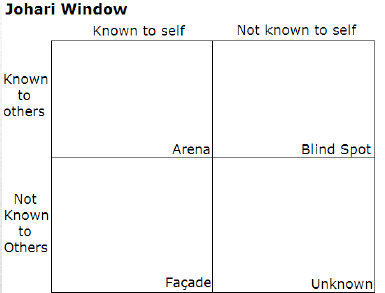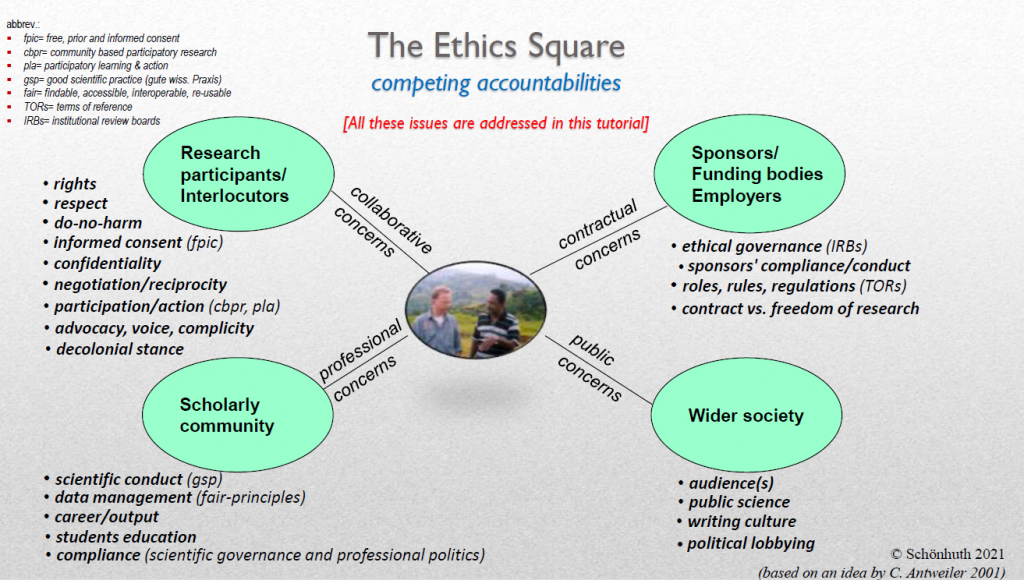II. Positioning
Location switching
The emic point of view

Grossmünster reflected in the Fraumünster’s Chagall window in Zürich (Switzerland). 3 Sep 2010
Roland zh.., Wikimedia Commons
Studying culture is like studying a church window: From the outside you can analyze its setting, demarcations, structure, form, components, texture.
But only from the inside will you learn its stories, its meaning, and the reasons, why people are touched by it.
(inspired by a Ghanain Proverb)
From known knowns to unknown unknowns
“Things we don’t know we don’t know”

Simon Shek http://en.wikipedia.org/wiki/Image:Johari_Window.PNG, Public Domain
Donald Rumsfeld Former Secretary of State , USA
“Reports that say that something hasn’t happened are always interesting to me, because as we know, there are known knowns; there are things we know we know. We also know there are known unknowns; that is to say we know there are some things we do not know. But there are also unknown unknowns -the ones we don’t know we don’t know”
(Donald Rumsfeld 2 Dec. 2002)
unknown unknowns: How is our research design leaving us open to surprise, to learning something unexpected,to understanding our topic from the various perspectives of the people in the community we are studying?
Liberation from the pressure to act
The “art” of abductive reasoning
The liberation from the prevailing pressure to act is the fundamental condition without which the boat will not sail […]. On this trip the sailor does not take with him his prior knowledge of an interpreted world. He leaves behind the firm convictions of the constitution of nature, of sociality and also of logic. What he takes along on the trip are only perceptions, not their hitherto proven interpretations.
(Jo Reichertz 1999: 57; my translation)
Beyond deductive and inductive reasoning: at the beginning there is surprise or even real shock, that one’s own explanatory patterns can no longer be viable and guide action in the field -as a prerequisite for the valid discovery of the ‘new’…”
Good read:
Serendipity
“A project should start with a project doing nothing…”
The serendipitous discovery of a new species of lacewing, Semachrysa jade, was made on Flickr…

Semachrysa jade female habitus Guek Hock Ping. Wikimedia Commons
Serendipity
- “the fact of something interesting or pleasant happening by chance”
- “We chose to invoke the mythological concept of serendipity to mark the intuitive logic that transcends both subjectivity and objectivity, by which fluid anthropological sense is articulated and constantly reformulated.” (Hasan/Hertzog 2012: 2)
- The statement: in the late 1990s an experienced development expert published an article entitled: “A project should start with a project doing nothing!”
- The message: a newly launched project should not spend money or pursue project goals, but only arrive, listen, learn and establish networks locally, so that by the end of the first year decisions could be made on how to adapt or reformulate original goals.
- The rationale behind this: program work in culturally unknown contexts has the best chance of success if in the beginning the pressure to act and the outflow of funds is removed from the system and a position is adopted which makes incomprehension a prerequisite for new insights…
- Point to ponder: How realistic is this in project settings that you are familiar with?
Good reads:
• Hasan, Haim and Esther Hertzog. 2012. eds. Serendipity in Anthropological Research. The Nomadic Turn. London: Ashgate.
• Merton, Robert K. and Elinor Barber. 2004. The Travels and Adventures of Serendipity: A Study in Sociological Semantics and the Sociology of Science. Princeton: Princeton University Press.
Is it all culture, or what?
Researching refugee centers

Complaint box in a German asylum centre.
Author: © Anett Schmitz 2018.
- Due to difficulties with the introduction of a complaint management system in refugee institutions in Germany, in 2018 our deparment was asked to advise the local administration with its cultural expertise, as it was assumed that refugees did not make proper use of the complaint possibilities offered (complaint forms in different languages, complaint boxes, independent ombudsmen) mainly for cultural reasons.
- Our ethnographic fieldwork revealed that the problem was not so much of a cultural as of a systemic kind: a functional complaint management requires trust in the system, something that refugees who do not yet have a secure residence permit are the least likely to have.
- Strauss’ scientific insights as an ethnographer in Indian psychiatry were also to a large extent insitution-specific, as her comparision with sociological and anthhropological studies in psychiatric contexts in Western settings showed: its authors described very analogous institutional (power) structures for this kind of ‘total institutions‘ (Goffman). (Strauss 2015: 94)
Buzz Group:
• Do you also know (conflict) situations that initially appeared to be cultural in nature, but then turned out to be not culture-bound?
• How would you react in place of the Trier anthropologists, if the insitution’s feedback was, that in view of the results, your cultural expertise would not have been required at all?
• Would this kind of anthropological reasoning – not cultural but systemic – still be “abductive”?
Good reads:
• Christ et al. 2019. All Day Waiting. Causes of conflict in refugee shelters in Germany.
• Abu-Lughod, Lila. 1991. Writing Against Culture. In: Richard G Fox (ed). Recapturing Anthropology: Working in the Present. Santa Fe, S. 137–162.
• Farmer, Paul. 2004. An anthropology of structural violence. Current Anthropology, 45(3), 305-325. doi: 10.1086/382250.
• Mclean, K.& C. Panter-Brick. 2018. Violence, Structural and Interpersonal. The Int. Encyclopedia of Anthropology, XII, 6368-6375. https://www.researchgate.net/publication/327454020_Violence_Structural_and_Interpersonal.
Self-positioning
Moralities and Ethics
“Much of anthropology is rooted in a broad commitment to moral relativityin one form or another. Moral relativity is not an excuse for abandoning anthropological ethics but rather is an invitation to anthropological ethics. From this standpoint, morality becomes pluralized (moralities).
As many anthropologists use the terms, ‘ethics’ refers to understandings of cause and effect that are the result of conscious reflection and attention, whereas ‘morality’ refers to default, taken-for-granted discourses and dispositions […].
Here, ethics involves reexamination of one’s own taken for granted moral stances, respect and consideration for other cultural traditions of morality, and reflection on how to resolve the juxtaposition of sometimes disparate moral discourses..”
(Steven B.Black (2016), at that time chair of the Committee on Ethics (CoE) of the American Anthropological Association (AAA) in a blog on ethics, anthropology, and adjudication)
- This tutorial is intended as an instrument for raising awareness of ethical dilemmas that arise from professionally engaging with local (cultural) contexts, that follow moral weaving patterns other than one’s own.
- The tutorial invites you to reflect on and weigh carefully “..on how to resolve the juxtaposition of sometimes disparate moral discourses”, as Steven B. Black put it some years ago (–>see left side).
- It is not bound to one single epistemological discourse such as the UN Charter of Human Rights, or a decolonial research ethics, although the author could sympathize with both.
- Where you position yourself between conflicting discourses and interests, you decide on your own – sometimes with a sound moral ‘guideline’ in your back, sometimes negotiating between stakeholders, if you are fortunate in consultation with a person you trust, and always anew.
Good read:
• Didier Fassin. 2008. Beyond Good and Evil? Questioning the anthropological Discomfort with Morals. Anthropological Theory 8,4,: 333-344.[describes the tension between the ‘cultural relativism’ that anthropologists defend and the ‘moral conviction’ that they share about universal values].
The Ethics Square


